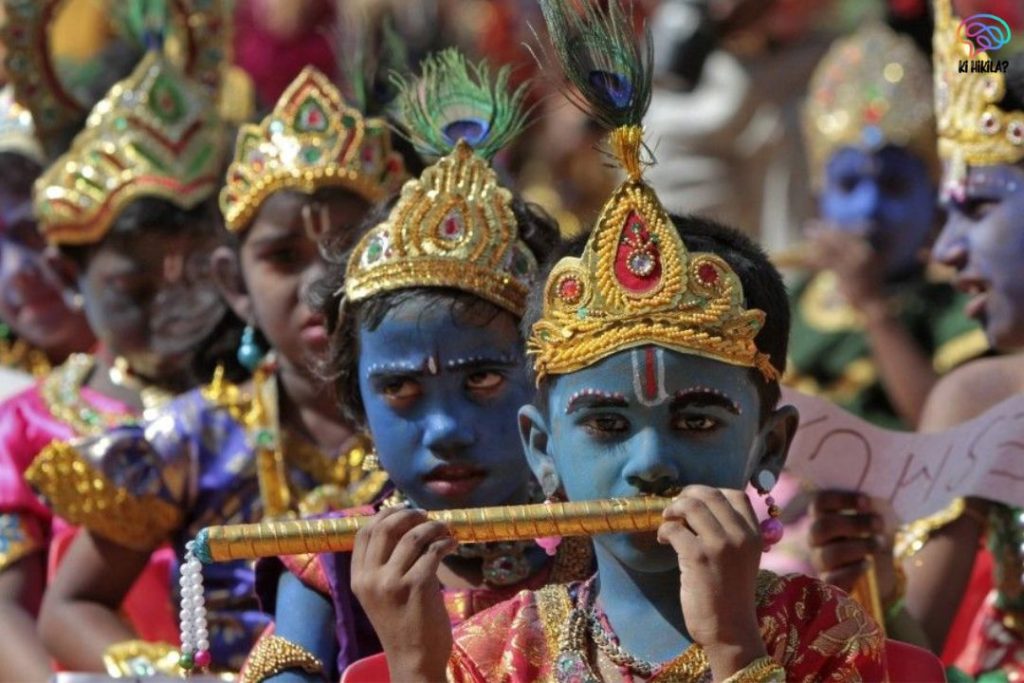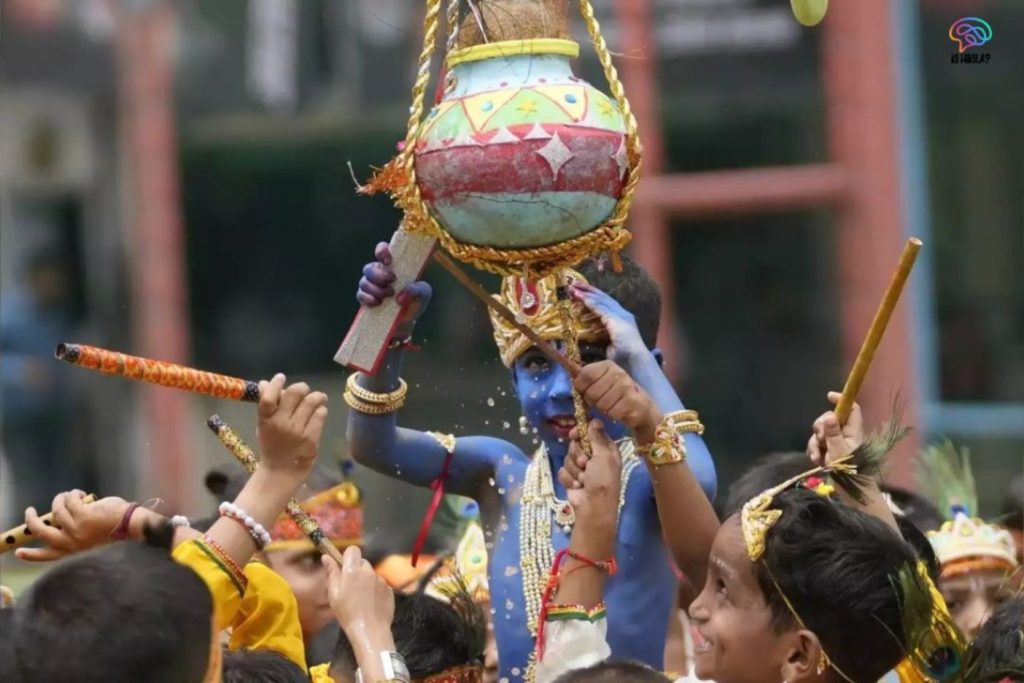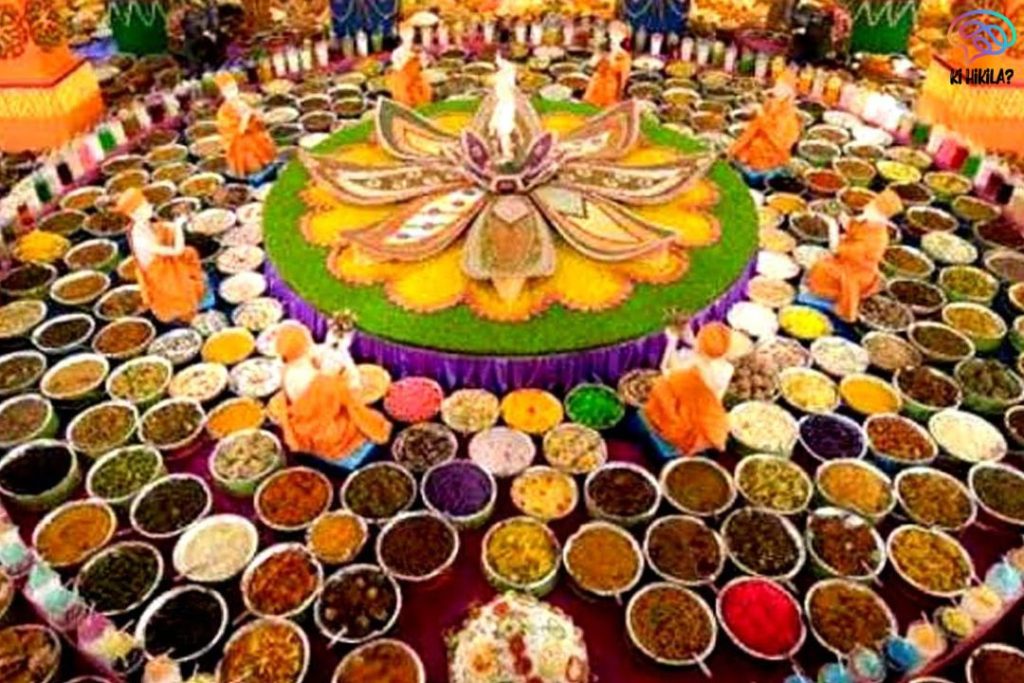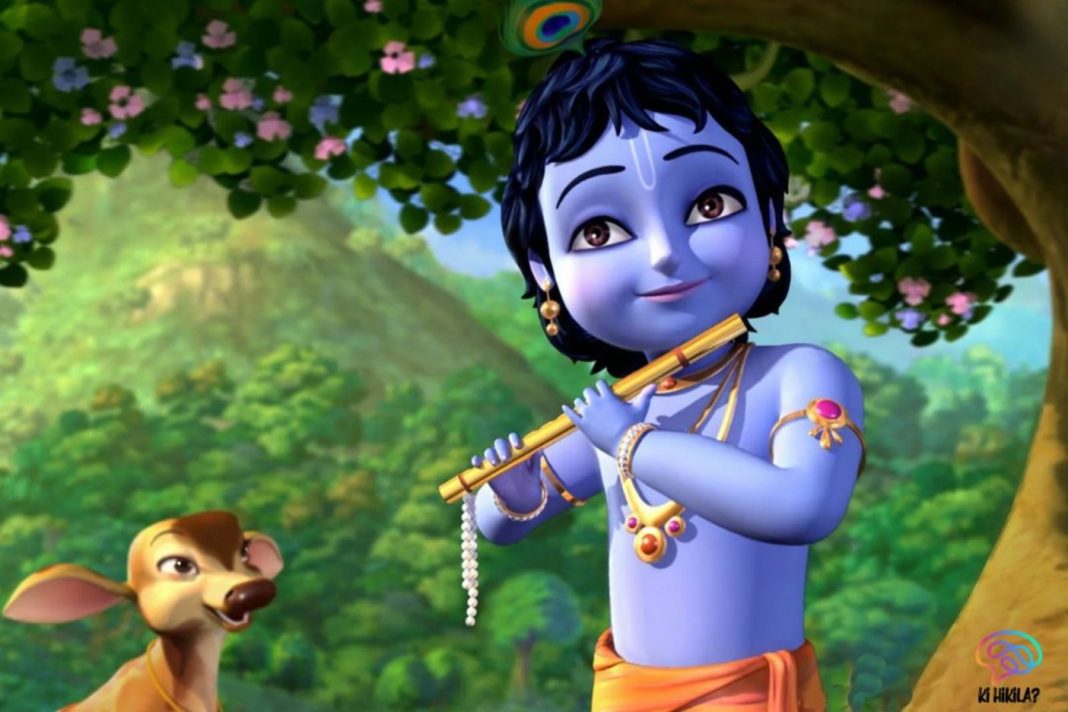Introduction to Krishna Janmashtami
Krishna Janmashtami is one of the most celebrated Hindu festivals, marking the birth of Lord Krishna, the eighth incarnation of Lord Vishnu. It is observed on the eighth day (Ashtami) of the Krishna Paksha (dark fortnight) in the month of Bhadrapada, according to the Hindu lunar calendar. In the Gregorian calendar, Krishna Janmashtami usually falls in August or September.
This festival is not only a religious occasion but also a cultural celebration. It combines devotion, traditional rituals, music, dance, and community gatherings. For millions of people, Krishna Janmashtami is a day of spiritual reflection, joy, and cultural pride.
The Mythological Story of Krishna Janmashtami
The Rule of King Kansa
In ancient times, the city of Mathura was ruled by King Kansa, known for his cruelty and injustice. He was the brother of Devaki, who was married to Vasudeva. According to a divine prophecy, the eighth child of Devaki would be the one to end Kansa’s life and free the people from his tyranny.
Birth and Rescue of Krishna
Fearing the prophecy, Kansa imprisoned Devaki and Vasudeva, killing their first six children. The seventh child, Balarama, was mystically transferred to Rohini’s womb. When Devaki was pregnant with her eighth child, Lord Vishnu appeared in a divine vision, telling them that this child would be his incarnation.
On the night of Krishna Janmashtami, heavy rains poured over Mathura. Miraculously, the prison gates opened, the guards fell asleep, and Vasudeva carried baby Krishna in a basket across the flooded Yamuna River to Gokul. There, Krishna was raised by Nanda and Yashoda, away from Kansa’s reach.
Significance of Krishna Janmashtami
Spiritual Meaning
Krishna Janmashtami reminds people of the eternal values of truth, righteousness, and compassion. Lord Krishna’s life and teachings, especially those in the Bhagavad Gita, serve as a guide to living with balance and purpose.
Symbolism of Good over Evil
The festival symbolizes the triumph of good over evil. Krishna’s birth brought hope and freedom to the people, ending the rule of injustice.
Cultural Importance
From traditional dances to devotional songs, Krishna Janmashtami strengthens cultural bonds across regions in India. It is celebrated by people of different languages, traditions, and customs.
How Krishna Janmashtami is Celebrated

Fasting and Devotion
Many devotees observe a fast, known as Nirjala Vrat, where they refrain from food and water until midnight. During the day, they chant Krishna’s name, read from the Bhagavata Purana, and sing devotional songs.
Midnight Birth Ceremony
The highlight of Krishna Janmashtami is the midnight celebration, believed to be the exact time of Krishna’s birth. Temples and homes place an idol of baby Krishna in a decorated cradle. Bells are rung, conch shells are blown, and prayers are offered.

Dahi Handi Tradition
In Maharashtra and other states, Dahi Handi is a popular activity. A clay pot filled with curd, butter, and sweets is hung high, and teams of young people form human pyramids to break it. This recreates Krishna’s playful habit of stealing butter.
Decorations and Cultural Programs
People decorate their homes with flowers, lights, and rangoli. Children often dress as Krishna or Radha. In temples, scenes from Krishna’s life, called Jhankis, are displayed for visitors.
Krishna Janmashtami Date for 2025
In 2025, Krishna Janmashtami falls on Saturday, August 16, though some observances begin the evening of Friday, August 15.
Why the Two Dates?
Because the lunar date (Ashtami Tithi) spans both dates, many rituals start on the evening of the 15th and culminate at midnight when Krishna is believed to be born The Times of IndiaRewynd SnacksIndia Times Bangla.
Ashtami Tithi Timing
- Begins: ~11:49 PM on August 15
- Ends: ~9:34 PM on August 16 The Times of IndiaRewynd Snacks
Nishita Puja (Midnight Puja)
- Per BankBazaar: ~12:03 AM – 12:47 AM on August 16 BankBazaar
- Per other calculations: ~12:00 AM (midnight) or slightly later The Times of IndiaRewynd Snacks
ISKCON-Specific Timings
According to ISKCON sources:
- Ashtami Tithi: ~1:19 PM on August 15 to ~11:04 AM on August 16
- Nishita Puja: ~1:17 AM – 2:00 AM on August 17 (by their schedule) Drik Panchang+1
Summary Table of Key Times
| Event | Date & Time (2025) |
|---|---|
| Ashtami Tithi Begin | ~11:49 PM, Aug 15 |
| Ashtami Tithi End | ~9:34 PM, Aug 16 (varies by source) |
| Main Janmashtami Day | Saturday, August 16, 2025 |
| Nishita (Midnight) Puja | ~12:00 AM – 12:47 AM, August 16 (varies) |
| ISKCON Midnight Puja | ~1:17 AM – 2:00 AM, August 17 |
Explanation in Simple Terms
- Why it’s on two dates: The festival starts the night of August 15, but the sacred moment—midnight when Krishna was born—is on August 16.
- Ashtami Tithi: This is the lunar day marked for celebration, starting late on the 15th and lasting until the evening of the 16th.
- Nishita Puja: A special midnight ritual that usually happens between 12:00 AM and 1:00 AM, though some traditions begin it later; ISKCON follows a slightly different schedule.
- For families and students: You can prepare from the evening of August 15, but the central, joyful part of Krishna Janmashtami is at midnight into August 16.
Krishna Janmashtami in Different Regions
- Mathura and Vrindavan – The most elaborate celebrations, lasting for several days with dramas, devotional singing, and processions.
- Maharashtra – Known for the energetic Dahi Handi competition.
- Gujarat – Raas Leela dances are performed to depict Krishna’s childhood stories.
- South India – People draw small footsteps at the entrance to welcome baby Krishna into their homes.
Teachings of Lord Krishna Highlighted on Krishna Janmashtami
- Perform your duty without expecting results – As taught in the Bhagavad Gita.
- Remain balanced in joy and sorrow – Face life’s ups and downs with calmness.
- Love and compassion are the highest virtues – Treat all beings with kindness.
- Faith in righteousness – Stand for truth even in difficult situations.

Food and Offerings on Krishna Janmashtami
On Krishna Janmashtami, devotees prepare special dishes such as:
- Makhan Mishri (butter mixed with sugar crystals) – Krishna’s favorite.
- Panjiri – A sweet offering made with wheat flour, sugar, and ghee.
- Peda and Laddu – Traditional sweets offered to the deity.
- Milk-based desserts like Kheer and Payasam.
These offerings are first given to the deity and then distributed as Prasadam to devotees.
Interesting Facts About Krishna Janmashtami
- It is also known as Gokulashtami in some states.
- In some places, celebrations last for two days, with the second day called Nandotsav.
- The festival is celebrated globally by the ISKCON community in more than 100 countries.
- Children often participate in fancy dress competitions as Krishna and Radha.
Conclusion
Krishna Janmashtami is a festival that blends devotion, tradition, and joy. It tells the story of a divine birth that changed the course of history, inspiring people to live by values of truth, love, and courage. Whether celebrated through midnight prayers, the thrill of Dahi Handi, or the gentle singing of devotional songs, Krishna Janmashtami continues to unite people in faith and happiness.
By remembering Krishna’s life and teachings on this day, devotees renew their commitment to living a life filled with compassion, wisdom, and righteousness.
Frequently Asked Questions on Krishna Janmashtami
1. What is Krishna Janmashtami?
Krishna Janmashtami is a Hindu festival that celebrates the birth of Lord Krishna, the eighth avatar of Lord Vishnu. It is observed on the eighth day (Ashtami) of the Krishna Paksha in the month of Bhadrapada, usually in August or September.
2. Why is Krishna Janmashtami celebrated at midnight?
According to Hindu belief, Lord Krishna was born at midnight. Devotees gather at this time to perform special prayers, sing devotional songs, and place the idol of baby Krishna in a cradle to mark his birth.
3. How is Krishna Janmashtami celebrated in India?
The celebrations include fasting, singing devotional songs, decorating temples and homes, performing dramas of Krishna’s life (Krishna Leela), and participating in events like Dahi Handi. The festival is celebrated differently across states such as Uttar Pradesh, Maharashtra, Gujarat, and Tamil Nadu.
4. What is the significance of fasting on Krishna Janmashtami?
Fasting is seen as a way to purify the body and mind. Devotees believe that observing a fast on Krishna Janmashtami brings spiritual blessings and shows devotion to Lord Krishna.
5. What is Dahi Handi and why is it part of Krishna Janmashtami?
Dahi Handi is a traditional event where a clay pot filled with curd, butter, and sweets is hung high, and teams form human pyramids to break it. It represents the playful nature of Krishna, who loved stealing butter as a child.
6. Which places in India are famous for Krishna Janmashtami celebrations?
Mathura and Vrindavan in Uttar Pradesh are the most famous, as they are associated with Krishna’s birth and childhood. Other popular locations include Maharashtra (Dahi Handi), Gujarat (Raas Leela dances), and South India (footstep decorations).
7. What special foods are prepared for Krishna Janmashtami?
Devotees prepare offerings like Makhan Mishri, Panjiri, Peda, Kheer, and various milk-based sweets, as Lord Krishna is believed to have loved dairy products.
8. Is Krishna Janmashtami celebrated outside India?
Yes. Krishna Janmashtami is celebrated by the Indian diaspora and ISKCON temples in countries like the United States, the United Kingdom, Australia, Canada, and many others, with cultural programs, devotional singing, and lectures on Krishna’s teachings.
9. What are some teachings of Lord Krishna remembered on this day?
Important teachings include doing one’s duty without expecting rewards, maintaining balance in success and failure, and living with love, compassion, and truth.
10. What is the difference between Janmashtami and Nandotsav?
Janmashtami marks Krishna’s birth, while Nandotsav is celebrated the next day to commemorate the joy and celebrations in Gokul after his birth.



